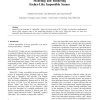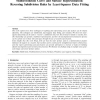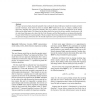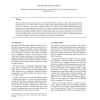103
click to vote
CGF
1999
15 years 17 days ago
1999
Inspired by the drawings of "impossible" objects by artists such as M.C. Escher, we describe a mathematical theory which captures some of the underlying principles of th...
106
click to vote
CGF
1999
15 years 17 days ago
1999
This work explores how three techniques for defining and representing curves and surfaces can be related efficiently. The techniques are subdivision, least-squares data fitting, a...
CGF
1999
15 years 17 days ago
1999
The paper presents simple, physically plausible, but not physically based reflectance models for metals and other specular materials. So far there has been no metallic BRDF model ...
116
click to vote
CGF
1999
15 years 17 days ago
1999
A fast design variation technique for mechanical systems is presented. It is used to interactively optimize mechanical characteristics while "self-assembling" or satisfy...
CGF
1999
15 years 17 days ago
1999
This paper presents a method for modelling graphics scenes consisting of multiple volumetric objects. A twolevel hierarchical representation is employed, which enables the reducti...
CGF
1999
15 years 17 days ago
1999
There has been a rapid technical progress in three-dimensional (3D) computer graphics. But gathering surface and texture data is yet a laborious task. This paper addresses the pro...
CGF
1999
15 years 17 days ago
1999
We present methods for creating 3D graphical models of scenes from a limited numbers of images, i.e. one or two, in situations where no scene co-ordinate measurements are availabl...
117
click to vote
CGF
1999
15 years 17 days ago
1999
Due to their simplicity and flexibility, polygonal meshes are about to become the standard representation for surface geometry in computer graphics applications. Some algorithms i...
108
click to vote
CGF
1999
15 years 17 days ago
1999
In this paper the notion of free form feature for aesthetic design is presented. The design of industrial products constituted by free form surfaces is done by using CAD systems r...
102
click to vote
CGF
1999
15 years 17 days ago
1999
The calculation of radiant energy balance in complex scenes has been made possible by hierarchical radiosity methods based on clustering mechanisms. Although clustering offers an ...




